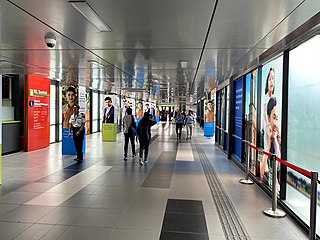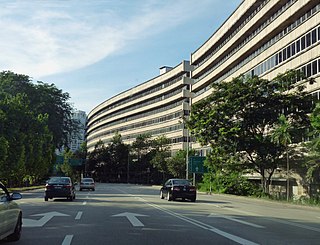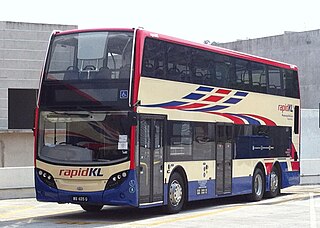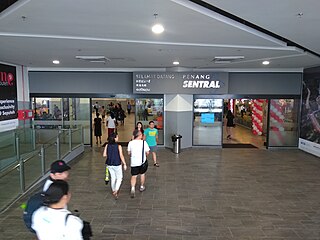
The KL Monorail Line is the eighth rail transit line and one of the operational monorail systems in Malaysia. Operated by Rapid Rail, a subsidiary of Prasarana Malaysia, it is one of the components of the Klang Valley Integrated Transit System. The line is numbered 8 and coloured Light Green on official transit maps.
Keretapi Tanah MelayuBerhad (KTMB) or Malayan Railways Limited is the main rail operator in Peninsular Malaysia. The railway system dates back to the British colonial era, when it was first built to transport tin. Previously known as the Federated Malay States Railways (FMSR) and the Malayan Railway Administration (MRA), Keretapi Tanah Melayu acquired its current name in 1962. The organisation was corporatised in 1992, but remains wholly owned by the Malaysian government.

Kuala Lumpur Sentral Station is a transit-oriented development that houses the main railway station of Kuala Lumpur, the capital of Malaysia. Opened on 16 April 2001, KL Sentral replaced the old Kuala Lumpur railway station as the city's main intercity railway station. KL Sentral is the largest railway station in Malaysia.

The Bukit Jalil National Stadium in Bukit Jalil, located in the National Sports Complex to the south of the city centre of Malaysia's capital city, Kuala Lumpur, all-seater multi-purpose stadium and the home ground of the Malaysian national football team. With a capacity of 87,411, it is the largest in Southeast Asia and the eighth largest football stadium in the world.
Prasarana Malaysia Berhad (Prasarana) is a 100% government-owned company which was set up by Ministry of Finance (Malaysia) as a corporate body established under the Minister of Finance (Incorporation) Act 1957 to own the assets of multi-modal public transport operator in Malaysia, under the government's move to restructure the city's public transport system. It is one of the largest public-transport companies in Malaysia other than Konsortium Transnasional Berhad. As a government-owned company since 1998, it operates stage bus and light metro services via several wholly owned subsidiaries.

The Express Rail Link Sdn Bhd is a company that owns and operates the airport rail link of the same name that connects the Kuala Lumpur International Airport (KLIA) with the Kuala Lumpur Sentral transportation hub, 57 kilometres apart. The company operates two different train services:
The East Coast Expressway is an interstate controlled-access highway running parallel to the northeastern coast of Peninsular Malaysia. The currently operational 433-kilometre (269-mile) segment of the expressway runs between Karak, Pahang and Kuala Nerus, Terengganu.

Pusat Bandar Damansara is a township in the Segambut constituency of Kuala Lumpur, Malaysia. The original buildings making up the township were constructed between 1981 and 1984, and were demolished in 2016 for new development.

Kuala Lumpur City Centre (KLCC) is a multipurpose development area in Kuala Lumpur, Malaysia. The area is located around Jalan Ampang, Jalan P. Ramlee, Jalan Binjai, Jalan Kia Peng and Jalan Pinang. There are also hotels within walking distance such as G Tower, Mandarin Oriental, Grand Hyatt Kuala Lumpur and InterContinental Kuala Lumpur.
Gamuda Berhad is an engineering, property and infrastructure company based Malaysia. It is one of the largest Malaysian infrastructure companies and has undertaken various projects, both locally and overseas, like the construction of Klang Valley MRT lines, highways, airport runways, railways, tunnels, water treatment plants, dams, infrastructure concessions and the development of new townships.

Bandar Sri Damansara is a residential township in northern Petaling Jaya, Selangor, Malaysia. The township is divided into two sections, SD1-SD5 in the north and SD7-SD15 in the south which are separated by Kuala Selangor-Kepong Highway. It is adjacent to Kepong and Sungai Buloh. The township consists of mixed development of commercial and residential properties. It was previously developed by Land and General Berhad and currently by TA Global.

Rail transport in Malaysia consists of heavy rail, light rapid transit (LRT), mass rapid transit (MRT), monorails, airport rail links and a funicular railway line. Heavy rail is mostly used for intercity passenger and freight transport as well as some urban public transport, while rapid transit is used for intra-city urban public transport in Kuala Lumpur, the national capital, and the surrounding Klang Valley region. There are two airport rail link systems linking Kuala Lumpur with the Kuala Lumpur International Airport and Sultan Abdul Aziz Shah Airport. The longest monorail line in the country is also used for public transport in Kuala Lumpur, while the only funicular railway line is in Penang.

Rapid Bus Sdn Bhd is the largest bus operator in Malaysia operating mainly in urban areas of Klang Valley, Penang & Kuantan. As of 2011, Rapid KL service brands unit of Rapid Bus, has operates 167 routes with 1,400 buses covering 980 residential areas with a ridership of about 400,000 per day.

Transportation in the Klang Valley, which includes Kuala Lumpur – the capital city of Malaysia – consists of highly-developed intermodal infrastructure. This includes an extensive road network, an integrated railway network, airports, and other modes of public transport. The Klang Valley is an urban conglomeration consisting of the city of Kuala Lumpur, as well as surrounding towns and cities in the state of Selangor. The Klang Valley has the country's largest airport, the Kuala Lumpur International Airport (KLIA), as well as the country's largest intermodal transport hub and railway station, Kuala Lumpur Sentral.

Bandar Bukit Tinggi is an integrated and modern township in Klang, Selangor, Malaysia. The RM5 billion self-sufficient mature township has a wide range of facilities and amenities.

Penang Sentral is an intermodal transit-oriented development in Butterworth, Penang, Malaysia. Proposed as the main transportation hub for the State of Penang, and by extension, Greater Penang, the first phase of the Penang Sentral project opened on 22 November 2018.

The MRT Kajang Line, previously known as the Sungai Buloh–Kajang Line, is a mass rapid transit (MRT) line servicing the Klang Valley, Malaysia. It is the ninth rail transit line and the second fully automated and driverless rail system in the Klang Valley area after the Kelana Jaya Line. It is a part of the Klang Valley Integrated Transit System. The line is numbered 9 and coloured Green on official transit maps.

The 37-kilometer LRT Shah Alam Line or LRT 3, previously known as the LRT Bandar Utama-Johan Setia Line, or simply LRT Johan Setia Line, is a light rapid transit (LRT) line that is slated to be the third LRT system in the Klang Valley. The line will be operated by Rapid Rail. It was announced by Prasarana Malaysia on 24 April 2013.

Kwasa Damansara is a new township located in the Subang constituency of Selangor, Malaysia. It borders Kota Damansara to the south and Sungai Buloh to the north. Currently in the process of development and construction, the development project is expected to take place over 20 years from 2015 and is part of the Greater Kuala Lumpur Strategic Development Project under the 10th Malaysia Plan announced in 2010.

The Muzium Negara station is an underground mass rapid transit (MRT) station in Kuala Lumpur, Malaysia on the Kajang Line. It is located beneath Jalan Damansara in front of the Muzium Negara, which gave the station its name.















